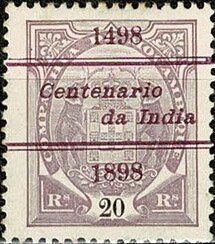Stamp: Elephants Overcharged 1498 Centenario… (Mozambique Company 1898)
Elephants Overcharged 1498 Centenario… (Mozambique Company 1898)
16 May (Mozambique Company ) within release Vasco da Gama's Voyage to India 400 Years (1898) goes into circulation Stamp Elephants Overcharged 1498 Centenario… face value 20 Mozambican (old) réis
| Stamp Elephants Overcharged 1498 Centenario… in catalogues | |
|---|---|
| Michel: | Mi: MZ-C 32C |
| Stamp Number: | Sn: MZ-C 49 |
| Yvert et Tellier: | Yt: MZ-C 34(B) |
| Afinsa-Mundifil: | Afi: MZ-C 33 |
Stamp is square format.
Sn describes paper as EnamelAlso in the issue Vasco da Gama's Voyage to India 400 Years (1898):
- Stamp - Elephants Overcharged 1498 Centenario… face value 15;
- Stamp - Elephants Overcharged 1498 Centenario… face value 20;
- Stamp - Elephants Overcharged 1498 Centenario… face value 50;
- Stamp - Elephants Surcharged 1498 Centenario… face value 25;
- Stamp - Elephants Overcharged 1498 Centenario… face value 150;
- Stamp - Elephants Overcharged 1498 Centenario… face value 200;
- Stamp - Elephants Overcharged 1498 Centenario… face value 75;
- Stamp - Elephants Overcharged 1498 Centenario… face value 100;
- Stamp - Elephants Overcharged 1498 Centenario… face value 300;
- Stamp - Elephants Overcharged 1498 Centenario… face value 10;
- Stamp - Elephants Overcharged 1498 Centenario… face value 75;
- Stamp - Elephants Overcharged 1498 Centenario… face value 15;
Stamp Elephants Overcharged 1498 Centenario… it reflects the thematic directions:
Animals are multicellular, eukaryotic organisms of the kingdom Animalia (also called Metazoa). All animals are motile, meaning they can move spontaneously and independently, at some point in their lives. Their body plan eventually becomes fixed as they develop, although some undergo a process of metamorphosis later on in their lives. All animals are heterotrophs: they must ingest other organisms or their products for sustenance.
A coat of arms is an heraldic visual design on an escutcheon (i.e. shield), surcoat, or tabard. The coat of arms on an escutcheon forms the central element of the full heraldic achievement which in its whole consists of shield, supporters, crest, and motto. A coat of arms is traditionally unique to an individual person, family (except in the United Kingdom), state, organisation or corporation.
Elephants are the largest living land animals. Three living species are currently recognised: the African bush elephant (Loxodonta africana), the African forest elephant (L. cyclotis), and the Asian elephant (Elephas maximus). They are the only surviving members of the family Elephantidae and the order Proboscidea; extinct relatives include mammoths and mastodons.
Mammals are any vertebrates within the class Mammalia (/məˈmeɪli.ə/ from Latin mamma "breast"), a clade of endothermic amniotes distinguished from reptiles (including birds) by the possession of a neocortex (a region of the brain), hair, three middle ear bones and mammary glands. All female mammals nurse their young with milk, secreted from the mammary glands. Mammals include the largest animals on the planet, the great whales. The basic body type is a terrestrial quadruped, but some mammals are adapted for life at sea, in the air, in trees, underground or on two legs. The largest group of mammals, the placentals, have a placenta, which enables the feeding of the fetus during gestation. Mammals range in size from the 30–40 mm (1.2–1.6 in) bumblebee bat to the 30-meter (98 ft) blue whale. With the exception of the five species of monotreme (egg-laying mammals), all modern mammals give birth to live young. Most mammals, including the six most species-rich orders, belong to the placental group. The largest orders are the rodents, bats and Soricomorpha (shrews and allies). The next three biggest orders, depending on the biological classification scheme used, are the Primates (apes and monkeys), the Cetartiodactyla (whales and even-toed ungulates), and the Carnivora (cats, dogs, seals, and allies).




